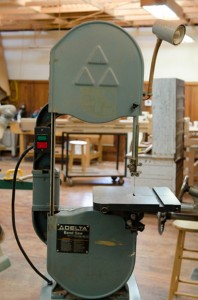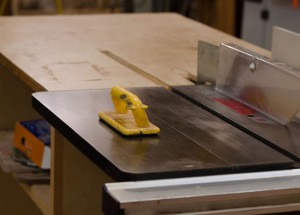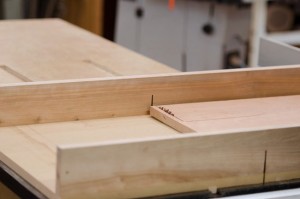Many of our students ask what machines they should buy. Because I am building furniture for a living, I mill most of my wood using large machines, but I do most of my joinery and finish work by hand. I have given much thought to what machines the average woodworker, working in his home shop, really needs. I have come to the conclusion that you really only need a couple of machines, and those are primarily for roughing down stock to close dimension prior to working it. In the day before those machines existed, this would have been the work of the apprentice, using hand tools.
The first machine I recommend is a bandsaw. With it you can rip down stock, cut large curves and do light re-sawing. Get at least a 14″ saw. A bandsaw is fairly safe and does not take up much room.
Second, I would also invest in a planer. You can find a new 13″ planer for around $500. You will need to get a small dust collector for the planer. You can get one that is fairly portable.
Although a tablesaw is pretty handy for the serious woodworker, there are several reasons I hesitate to recommend it. The first is safety. It is the number one power tool in terms of causing shop accidents. It also takes up a lot of space. Instead of using a tablesaw, you can rip your boards on either the bandsaw or by hand.
On the other hand, if you do decide to invest in a tablesaw, you must, and I will say it again, you must have an outfeed table. Do not run the saw without an outfeed table. An outfeed table supports the stock so that when you are ripping, the piece you are cutting does not fall off the back of the saw. Without the outfeed table it is very easy to put your hand into the blade while trying to hold up or catch your stock.
If you decide to get a tablesaw, take some time to build a crosscut sled as well. A simple crosscut sled will enable you to make crosscuts easily, accurately and safely.
Remember that you can mill rough wood using a few simple hand planes. I have two #5 Stanley planes for roughing my stock. I think you can pick these up for around $30 to $40 each. If you sharpen one with a convex blade, you can use it for “hogging” off stock rapidly. You then come back with another more finely set #5 for getting the high spots off. After you get one face flat, and free of any bow, cup or twist, you can run it through the planer to make both faces parallel. The whole process goes pretty fast. If you don’t have access to a planer, you can plane your wood flat, square and free of cup and twist using hand planes, a marking gauge, a straightedge and winding sticks. This is how boards were flattened for many years.
To sum up, you really don’t need thousands of dollars worth of woodworking machinery—all you need is the right hand tools, a few machines to speed things up if you need to, and above all, skill to use your tools. Check out our woodworking courses here on SustainLife.org.
Frank Strazza



Comments are closed.